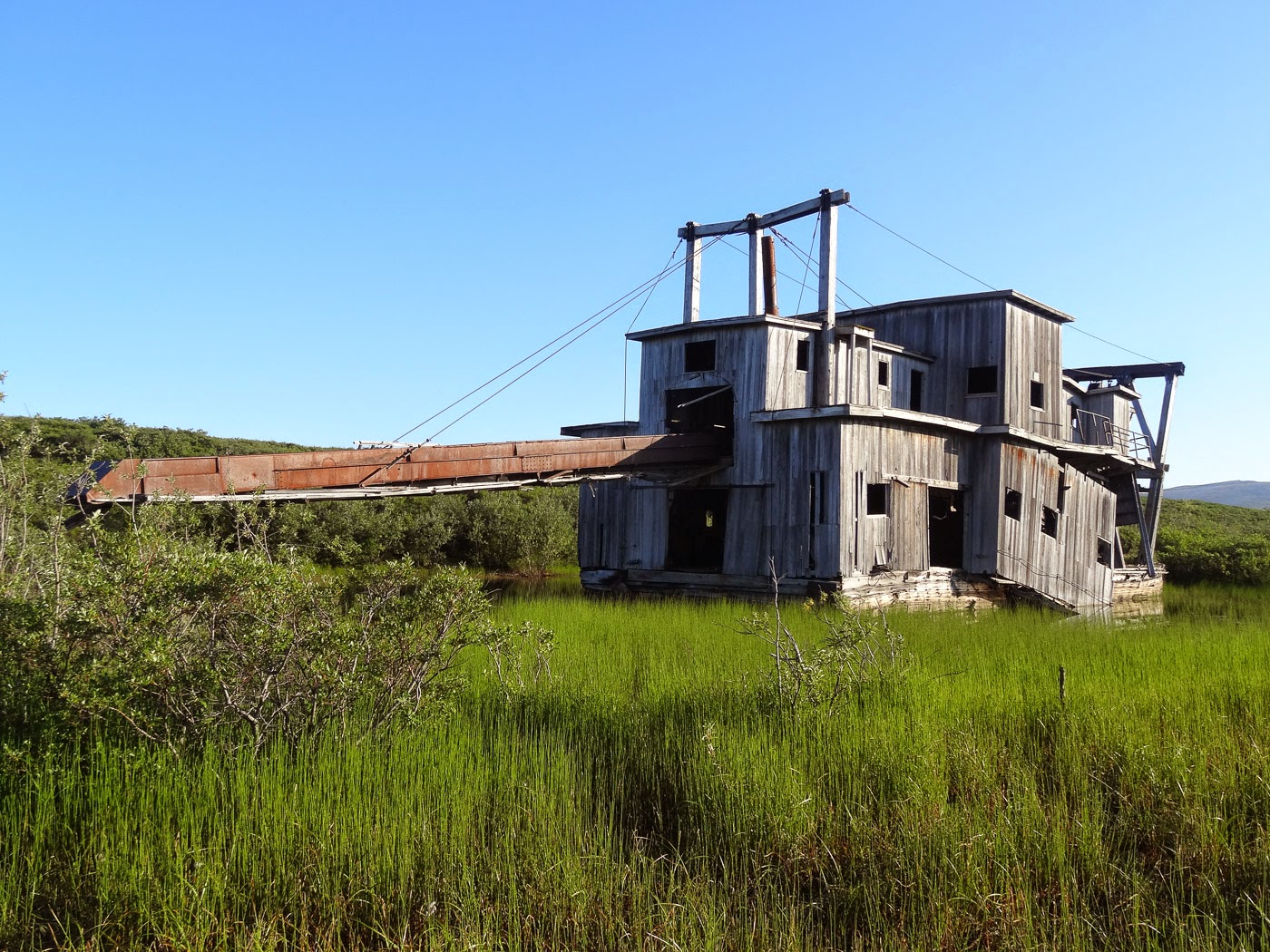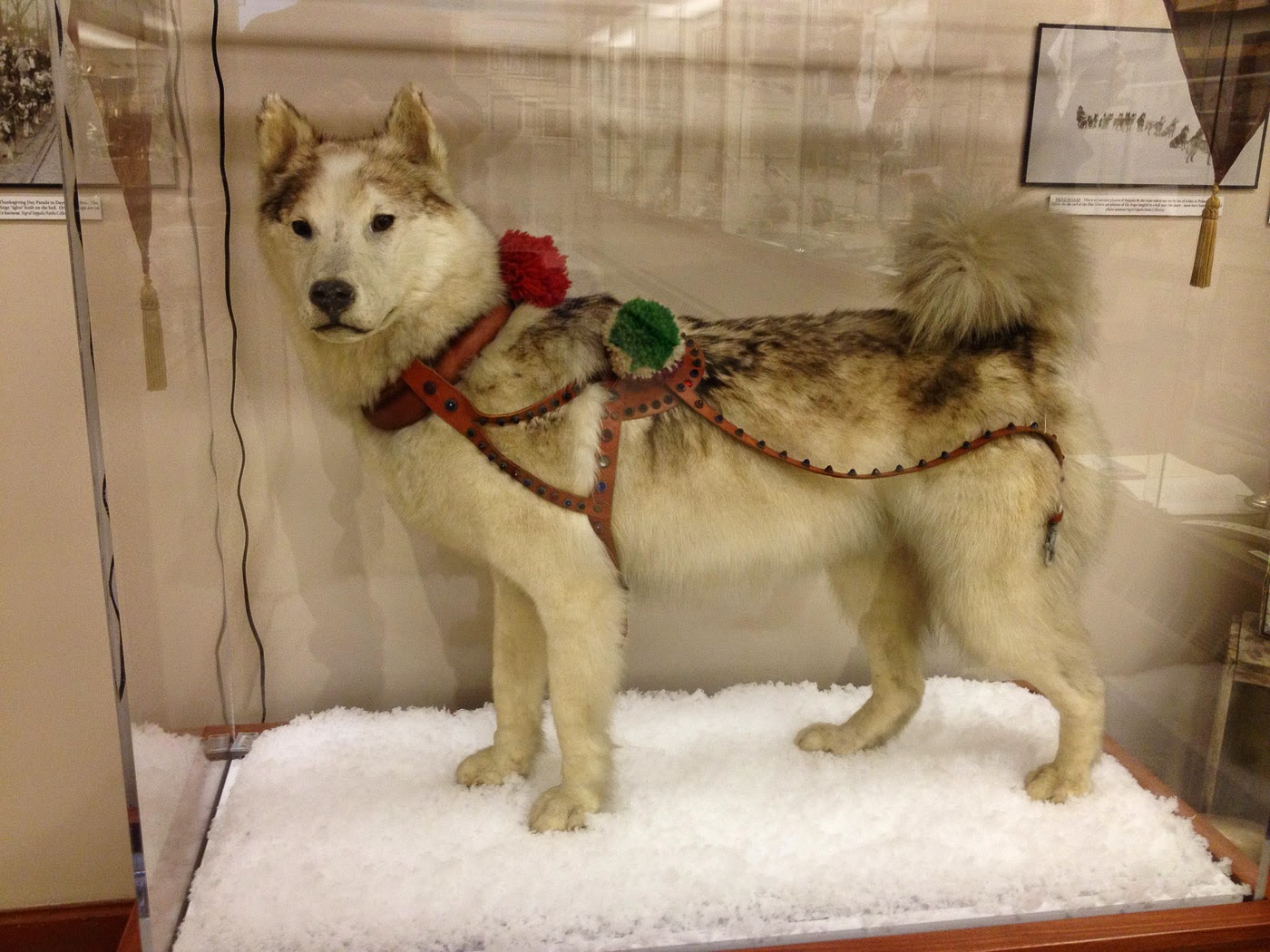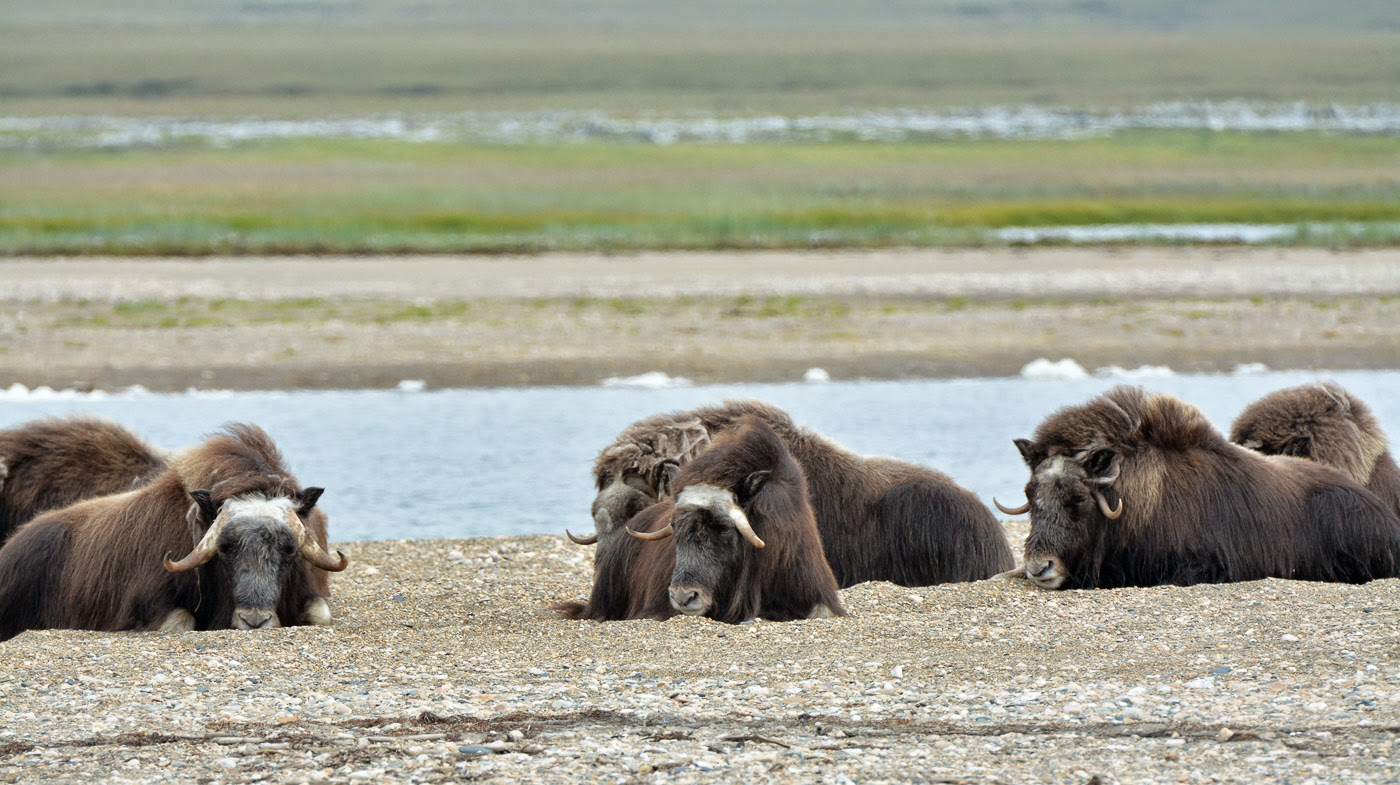The locals claim there's no place like Nome and I couldn't agree more. We've spent the last 4 days exploring Nome, Alaska and the surrounding environs. What makes Nome so special? Is it that Nome is home to the world's largest gold mining pan (although a Canadian town claims to have a bigger one)?
 |
| World's Largest Gold Mining Pan |
Probably not but Nome's colorful gold rush history is a good guess. On September 22, 1898, three men from Sweden ("The Three Lucky Swedes") discovered gold in Anvil Creek causing 40,000 people to flood into Nome seeking fortune. The gold was readily accessible having washed down the creeks from the mountains to the beach. Later a dredge was used to mine on a larger scale.
 |
| Into the Belly of the Monster |
A dredge is a strange contraption, a floating excavator and sluicing plant. It contains a belt of digging buckets that scoop up "pay" dirt and deposit it into a hopper. The gravel is then fed into a trammel that sorts course rock from finer gold-bearing sand and gravel. The worthless gravel is dumped directly out the back while the sediments containing the gold fall into sluice boxes. Dredges now stand abandoned and the digging buckets make unique planters.
 |
| Digging Bucket Planter |
Today the population of Nome is around 3700 and mining continues on a much smaller scale.
Another special aspect of Nome is that it is the terminus of the famous Iditarod Trail Sled Dog Race.
 |
| End of Iditarod Trail Sled Dog Race |
Every year mushers embark on the 1049-mile journey from Anchorage to Nome via dog sled. What would prompt anyone to make such an arduous journey in the dead of winter? The answer is surprising and inspiring. In 1925 a diphtheria epidemic broke out in Nome. There was no easy way to get the life-saving serum from Anchorage to Nome. The only option was to send the serum by train from Anchorage to Nenana where a relay of mushers was set up to take the medicine to Nome via dog sled. Leonhard Seppala had already traveled 169 miles by dog sled from Nome to pick up the serum and carried it back 91 miles to the next stage. One of his lead dogs was named Fritz. In 1932 Fritz was brought to Lake Placid, NY for an exhibition. He died there from old age and was taxidermied. No one knew where he was for 73 years. He was discovered and returned to Nome and now resides in the Carrie M. McLain Memorial Museum.
 |
| Fritz, the Famous Sled Dog |
The first Iditarod was run in 1967 and was called the Iditarod Trail Leonhard Seppala Memorial Race. Seppala had died in January of that year. It was the 1925 serum run from Nenana to Nome that inspired today's Iditarod Trail Dog Sled Race.
Nome lies on the Bering Sea just south of the Arctic Circle, not far from here the Bering Land Bridge that once connected Asia to North America. It was by way of the bridge that humans first arrived on the North American Continent 13,000 years ago. Humans spread rapidly eastward and southward over the Americas as depicted in the following map.
 |
| Peopling the Americas |
Many plants and other animals also moved between continents via the land bridge also called Beringia. Three main gravel roads lead from Nome to remote villages covering 250 miles of wild lands.
 |
| The Roads (in red) we Explored |
We spent the last 4 days exploring these roads in search of wildlife and to gain an insight into the subsistence way of life maintained by many native people. Our main quarry was the muskox, a prehistoric looking beast with a shaggy coat and long curved horned. By the end of the 19th century they were wiped out from Alaska but in 1970 thirty-four muskox from Greenland were transplanted into Alaska. The herd has thrived and is now thought to be around 3000 animals on the Seward Peninsula. During our explorations we encountered 3 herds ranging from 15 to 41 animals and two lone bulls. One bull near the village of Teller was close to the road and posed nicely for us.
 |
| Muskox Bull |
Not everyone in Nome is happy about the successful reintroduction of muskox. Some of the muskox wander into town and have been known to attack and kill dogs. As a result the muskox will be hunted for the first time this year. Five permits have been issued. I don't think it will be much of a hunt. Today we spotted a small herd from the bridge crossing Bonanza Channel. We walked about a mile and a half down the beach and came to within 150 feet of the herd. They were not alarmed and continued to lounge contentedly on the beach.
 |
| Muskox on the Beach |
I felt privileged that these animals trusted us and allowed us to approach so closely. It saddens me to know that this trust will be shattered once the first bullet is fired and the first muskox falls at the hand of man.
We did encounter a few other animals during the course of our Arctic safaris. A lone caribou yearling was acting strangely along the banks of the Tisuk River. She cavorted about playfully and stopped to sniff the ground like a bloodhound. I wondered where the rest of her herd was. Why had she been left alone?
 |
| Lone Caribou |
Arctic Ground Squirrels scurried alongside the road and disappeared just as soon as we stopped to photograph them. Finally we caught one unawares and snapped his photo.
 |
| Arctic Ground Squirrel |
A Red Fox was trotting across the tundra in search of food. He had shed most of his winter fur but his tail remained fluffy and looked ridiculously too large for his body.
 |
| Red Fox |
The Bob Blodgett Nome-Teller Highway winds 72 miles across tundra to the tiny outpost of Teller. The village lies along a spit of land jutting into Grantley Harbor.
 |
| Teller |
People here live a mainly subsistence lifestyle with fishing playing a main role.
 |
| Drying Fish |
In May 1926, Teller made international headlines when Roald Amundsen landed here in his blimp called the Norge.
 |
| Amundsen's Air Ship |
He had just made the first Arctic flight from Europe to North America! He left Spitsbergen, Norway, flew over the North Pole and was forced to land at Teller due to weather, even though his destination was Nome. Amundsen really got around. He was the first to the South Pole, the first to sail through the Northwest Passage and the first to fly from Europe to North America!
So when the local claim there is no place like Nome, they're not kidding!!
We hope all is well back home,
Peggy and Marc

3 comments:
A joy to read! Thanks for sharing,
Jeannette
Thank you for writing a journal with such come alive description! The animals, the background to such an interesting corner of the world, the photos, the historical vignettes...so compelling! Thank you.
Donna W.
Fantastic insights into sled dog traditions. If you’re curious about the mechanics behind it, here’s a detailed post on How Sled Dog Harnesses Work and Why They Matter — really informative!
Post a Comment